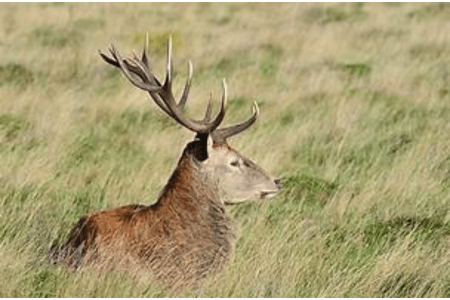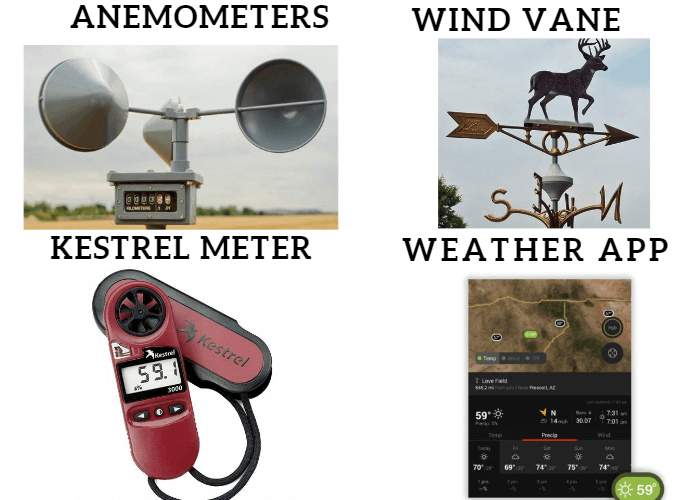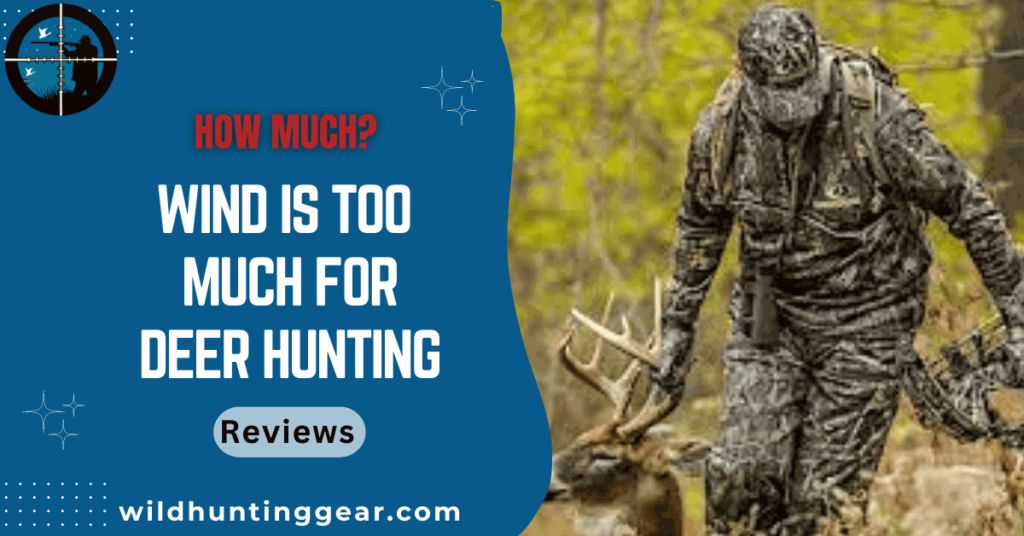Deer hunting is a popular outdoor activity enjoyed by many hunting enthusiasts. It requires skill, patience and a deep understanding of the natural elements that can affect the success of a hunt. One such element is wind, which plays a crucial role in determining the outcome of a deer hunting expedition.
While wind can be advantageous for hunters by masking their scent and helping to conceal their movements, too much wind can create challenges for hunters.
In this article, we will explore how much wind is too much for deer hunting, examining the factors to consider, the potential impact of excessive wind and strategies hunters can employ to maximize their chances of success in various wind conditions.
By gaining insight into the effects of wind on deer behaviour and hunting tactics, hunters can make informed decisions and optimize their hunting experiences in different wind scenarios.
The Role of Wind in deer hunting

Wind plays an important role in deer hunting, affecting the behaviour of both deer and hunters. Deer have a highly sensitive sense of smell and use wind direction to detect potential threats. When a dominant wind direction is present, deer are likely to remain downwind of potential predators or disturbances.
This means that if a hunter is positioned upwind of the animal there is a greater chance of success in bagging the animal as its sense of smell will not be able to detect the hunter’s presence.
At the same time, excessive winds can create a challenge for hunters by masking their scent and making it more difficult for deer to detect them. They can also disrupt the hunter’s aim due to strong gusts that can cause bullets to miss their target.
In addition, wind can affect the terrain of an area by moving foliage and creating noise that can scare deer away.
How much wind is too much for deer hunting?
It is difficult to determine exactly how much wind is too much for deer hunting as it largely depends on the region, season and other environmental factors. In general, wind speeds over 15 mph can make deer hunting difficult as the noise and movement caused by the wind can spook deer and disrupt their normal behaviour.
In addition to the speed of the wind, hunters should also consider the direction of the wind when choosing a location for hunting. If possible hunters should choose a spot where they will have downwind from potential deer.
This will allow them to remain undetected and in a position where they can make a successful shot if an opportunity presents itself.
Regardless of the wind speed hunters should always be aware of how it is affecting their ability to hunt effectively. If the wind speeds become too high or conditions are otherwise unfavourable it may be best to move on and try another location for better success. With patience and awareness, hunters can still have a successful hunting trip despite strong winds.
Ultimately, there is no single answer as to how much wind is too much for deer hunting as every situation has its unique conditions that must be taken into account.
Hunters should use their best judgement when determining whether or not current wind speeds are too strong for a successful hunt. When in doubt it is best to err on the side of caution and look for a better hunting spot.
With proper preparation and an understanding of wind patterns, hunters can still have success even on the windiest days.
Strategies for hunting deer in windy conditions
Here are some strategies to help you stay successful while hunting in windy conditions:
- Use the wind to your advantage:
Try positioning yourself downwind of where you expect the deer to be, so as not to alert them to your presence. Also, remember that different deer species will respond differently when it comes to the wind. For example, whitetail deer tend to move more easily into headwinds while mule deer prefer tailwinds when they’re on the move.
- Find natural shelters:
Make sure you take advantage of natural shelters like fallen trees or rock outcroppings that can block your scent from passing through the wind. If you’re hunting in an open field, look for nearby trees or tall grasses that can help break up your silhouette.
- Use calls and scents:
Even if the wind is blowing fiercely, deer calls and scents can still be effective at drawing deer in from a distance. Try using a cover scent, but use it sparingly as too much scent could spook the deer away.
- Double up on your clothing:
Dress for success by wearing layers to keep warm and dry during windy conditions. The added layers of clothing will also help break up your outline when seen from a distance and make it more difficult for deer to pick up your presence.
- Be patient:
Hunting in windy conditions requires a lot of patience as deer will be moving around less and taking longer to respond to your calls. Take your time and practice proper field etiquette by waiting until you’re sure deer are in range before shooting.
These strategies can help ensure that you stay successful while hunting deer in windy conditions, while also keeping yourself safe and comfortable.
How to take the best advantage of strong winds during deer hunting?
- Utilize the wind to cover your scent by positioning yourself downwind and away from the deer’s anticipated approach.
- Use decoys as a distraction while you prepare for a shot in open areas with strong winds.
- Take into consideration the speed and direction of the wind when selecting a shooting location as crosswinds can alter the trajectory of shots.
- Position yourself away from the sun and wind to maximize your visibility and reduce glare when aiming.
- Utilize taller grass, trees or other vegetation that can act as natural camouflage while using the wind to stay undetected by deer in the area.
- Wear clothing with a camouflage pattern and select materials that don’t rustle in the wind to reduce the chances of being spotted.
- Scope out areas with good cover and visibility while considering the strength of the winds when scouting for deer activity.
- Adjust shooting techniques according to wind speed and direction, taking into account any changes or variations during your hunt.
- Opt for lighter weight and smaller firearms for increased mobility while hunting in windy conditions.
- Be knowledgeable about the area’s weather patterns and understand when to expect higher winds for better or worse during deer season.
Factors to consider when assessing wind conditions for deer hunting.
| Factor | Considerations |
| Wind Direction | Deer tend to move with the wind, so it is important to consider the direction of the wind when assessing deer hunting conditions. If a hunter is downwind from a deer, they may detect human scents and avoid the area. It’s better if hunters can set up downwind or crosswind to increase chances of success. |
| Wind Speed | Wind speed affects how deer move and react in the environment. If the wind is too strong, it can reduce a hunter’s visibility by blowing leaves, snow or dust into their line of sight. Conversely, if the wind is too light the scents from a hunter may more easily travel, so it is important to find a balance. |
| Temperature | Temperature affects how deer act and behave, so it needs to be taken into consideration when assessing wind conditions for hunting. In cold climates, deer may hunker down in areas with low wind speeds to keep warm, while in warmer climates they may seek out areas of higher winds for cooling. Additionally, the temperature can affect the scent of humans and other animals in the area. | |
| Precipitation | Rain, snow or fog can all affect deer behaviour and create unfavourable hunting conditions. When assessing wind conditions, a hunter should take into account any potential precipitation that may occur and plan accordingly. |
| Humidity | Humidity can affect a variety of things, including the scent of animals and humans in an area. High humidity makes it harder for deer to detect human scents, making it more difficult for hunters to track them down. On the other hand, low humidity can make it easier for deer to detect human scents, making it more difficult for hunters to remain undetected. |
| Air Pressure | Air pressure can affect the behaviour of deer, as they tend to be more active during periods of low air pressure. Generally, lower air pressure can also make it easier for human scents to travel further, so hunters should take this into account when assessing wind conditions. |
| Terrain | The terrain in an area can have a significant effect on wind patterns. Areas with hills, valleys or thick vegetation can cause the wind to be unpredictable and difficult to predict. This means that it is important for hunters to take into account any changes in terrain when assessing wind conditions. |
| Time of Day | The time of day can also have an influence on wind conditions. During early morning hours, when air is generally calmer, deer may be more active and easier to spot.Additionally, hunting in the late afternoon or evening can result in stronger winds that make it more difficult to detect scents. |
| Location | A hunter’s location can determine what type of terrain they will be hunting in and what types of wind patterns they will be dealing with. For example, hunters in the mountains may be dealing with higher winds than those closer to sea level. Hunters should take their location into account when assessing wind conditions for deer hunting. |
| Other Factors | Other factors such as vegetation and animal activity can also affect wind conditions. Heavy vegetation can reduce the strength of the wind, while animal activity can cause changes in wind patterns. A hunter should always take these factors into consideration when assessing wind conditions for deer hunting. |
By taking all of the above considerations into account when assessing wind conditions for deer hunting a hunter can increase their chances of success and have a more enjoyable experience.
Wind measurement tools and resources

In addition to understanding how the various factors affect wind conditions, hunters can also use certain tools and resources to help measure and monitor them.
The following are a few of the most useful wind measurement tools and resources:
- Anemometers
These small devices measure air velocity in different directions and can help a hunter assess which direction the wind is blowing from.
- Wind vane
This tool is a device used to measure the direction of the wind. It consists of a metal plate with sections labelled
in degrees that can be adjusted depending on the direction of the wind.
- Kestrel meter
A Kestrel Meter measures temperature, wind speed and relative humidity and can give hunters an idea of what they should expect when hunting in a certain area.
- Weather app
There are many different weather apps available that can provide hunters with detailed information on wind conditions in an area including wind speed and direction.
Using these tools and resources to measure wind conditions can help give hunters the information they need to make the most out of their deer hunting experience.
By taking into account all of the factors discussed above and using the right tools and resources a hunter can better assess wind conditions for deer hunting and increase their chances of success.
Final Thoughts
The wind plays a significant role in deer hunting and can both hinder and enhance the hunting experience depending on its strength and direction. High wind speeds typically over 20 mph can prove too much for deer hunting. Such conditions could lead to decreased deer activity as they seek cover and hinder the hunter’s ability to move silently or accurately shoot.
However, moderate winds can be advantageous for masking noise and scent. Thus, understanding wind patterns and using them strategically is crucial for successful deer hunting.




